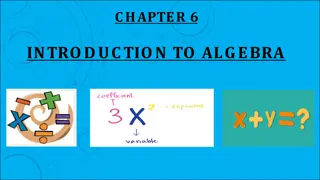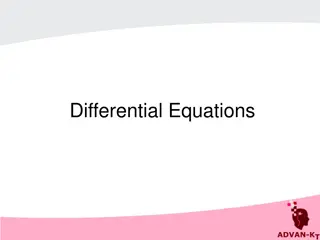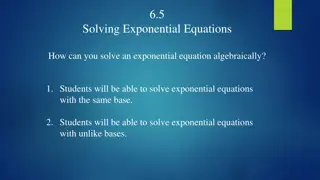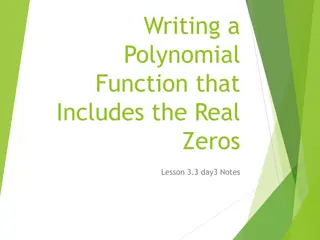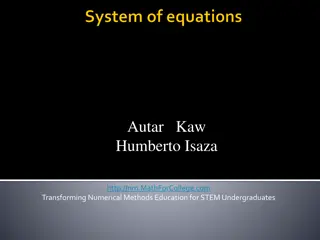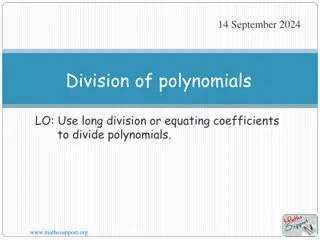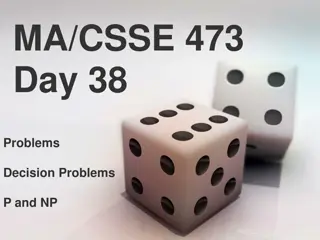
Mastering Polynomial Equations: Algebra 2 Chapter 4
Explore how to add, subtract, and multiply polynomial expressions in Algebra 2 Chapter 4. Learn important concepts such as combining like terms, using the distributive property, and special product patterns. Enhance your algebra skills with practical examples and diagrams from the accompanying textbook.
Download Presentation

Please find below an Image/Link to download the presentation.
The content on the website is provided AS IS for your information and personal use only. It may not be sold, licensed, or shared on other websites without obtaining consent from the author. If you encounter any issues during the download, it is possible that the publisher has removed the file from their server.
You are allowed to download the files provided on this website for personal or commercial use, subject to the condition that they are used lawfully. All files are the property of their respective owners.
The content on the website is provided AS IS for your information and personal use only. It may not be sold, licensed, or shared on other websites without obtaining consent from the author.
E N D
Presentation Transcript
Solve Polynomial Solve Polynomial Equations Equations Algebra 2 Chapter 4
This Slideshow was developed to accompany the textbook Big Ideas Algebra 2 By Larson, R., Boswell 2022 K12 (National Geographic/Cengage) Some examples and diagrams are taken from the textbook. Slides created by Richard Wright, Andrews Academy rwright@andrews.edu 2
Objectives: Add and subtract polynomial expressions. Multiply polynomial expressions. 4 4- -01 Add, Subtract, and 01 Add, Subtract, and Multiply Polynomials (4.2) Multiply Polynomials (4.2) 3
4 4- -01 Add, Subtract, and Multiply 01 Add, Subtract, and Multiply Polynomials (4.2) Polynomials (4.2) Adding, subtracting, and multiplying are always good things to know how to do. Sometimes you might want to combine two or more models into one big model. 4
4 4- -01 Add, Subtract, and Multiply 01 Add, Subtract, and Multiply Polynomials (4.2) Polynomials (4.2) Adding and subtracting polynomials Add or subtract the coefficients of the terms with the same power. Called combining like terms. Simplify (5x2 + x 7) + ( 3x2 6x 1) (3x3 + 8x2 x 5) (5x3 x2 + 17) 5
4 4- -01 Add, Subtract, and Multiply 01 Add, Subtract, and Multiply Polynomials (4.2) Polynomials (4.2) Multiplying polynomials Use the distributive property Simplify (x 3)(x + 4) (x + 2)(x2 + 3x 4) 6
4 4- -01 Add, Subtract, and Multiply 01 Add, Subtract, and Multiply Polynomials (4.2) Polynomials (4.2) (x 1)(x + 2)(x + 3) 7
4 4- -01 Add, Subtract, and Multiply 01 Add, Subtract, and Multiply Polynomials (4.2) Polynomials (4.2) Special Product Patterns Sum and Difference (a b)(a + b) = a2 b2 Square of a Binomial (a b)2 = a2 2ab + b2 Cube of a Binomial (a b)3 = a3 3a2b + 3ab2 b3 8
4 4- -01 Add, Subtract, and Multiply 01 Add, Subtract, and Multiply Polynomials (4.2) Polynomials (4.2) (x + 2)2 (x 3)2 9
Objectives: Factor polynomial expressions. Solve polynomial equations by factoring. 4 4- -02 Factor and Solve 02 Factor and Solve Polynomial Equations Polynomial Equations (4.4) (4.4) 10
4 4- -02 Factor and Solve Polynomial 02 Factor and Solve Polynomial Equations (4.4) Equations (4.4) A manufacturer of shipping cartons who needs to make cartons for a specific use often has to use special relationships between the length, width, height, and volume to find the exact dimensions of the carton. The dimensions can usually be found by writing and solving a polynomial equation. This lesson looks at how factoring can be used to solve such equations. 11
4 4- -02 Factor and Solve Polynomial 02 Factor and Solve Polynomial Equations (4.4) Equations (4.4) How to Factor 1. Greatest Common Factor Comes from the distributive property If the same number or variable is in each of the terms, you can bring the number to the front times everything that is left. 3x2y + 6xy 9xy2 = Look for this first! 12
4 4- -02 Factor and Solve Polynomial 02 Factor and Solve Polynomial Equations (4.4) Equations (4.4) 2. Check to see how many terms Two terms (formulas) Difference of two squares: a2 b2 = (a b)(a + b) 9x2 y4 = Sum of Two Cubes: a3 + b3 = (a + b)(a2 ab + b2) 8x3 + 27 = Difference of Two Cubes: a3 b3 = (a b)(a2 + ab + b2) y3 8 = 13
4 4- -02 Factor and Solve Polynomial 02 Factor and Solve Polynomial Equations (4.4) Equations (4.4) Three terms (General Trinomials ax2 + bx + c) Write two sets of parentheses ( )( ) Guess and Check The Firsts multiply to make ax2 The Lasts multiply to make c The Outers + Inners make bx x2 + 7x + 10 = 6x2 7x 20 = 14
4 4- -02 Factor and Solve Polynomial 02 Factor and Solve Polynomial Equations (4.4) Equations (4.4) Four terms (Grouping) Group the terms into sets of two so that you can factor a common factor out of each set Then factor the factored sets (Factor twice) b3 3b2 4b + 12 = 15
4 4- -02 Factor and Solve Polynomial 02 Factor and Solve Polynomial Equations (4.4) Equations (4.4) 3. Try factoring more! a2x b2x + a2y b2y = 16
4 4- -02 Factor and Solve Polynomial 02 Factor and Solve Polynomial Equations (4.4) Equations (4.4) 3a2z 27z = n4 81 = 17
4 4- -02 Factor and Solve Polynomial 02 Factor and Solve Polynomial Equations (4.4) Equations (4.4) Solving Equations by Factoring 1. Make = 0 2. Factor 3. Make each factor = 0 because if one factor is zero, 0 time anything = 0 18
4 4- -02 Factor and Solve Polynomial 02 Factor and Solve Polynomial Equations (4.4) Equations (4.4) 2x5 = 18x 19
Objectives: Divide polynomials with long division. Divide polynomials with synthetic division. 4 4- -03 Divide Polynomials 03 Divide Polynomials (4.3) (4.3) 20
4 4- -03 Divide Polynomials (4.3) 03 Divide Polynomials (4.3) So far we done add, subtracting, and multiplying polynomials. Factoring is similar to division, but it isn t really division. Today we will deal with real polynomial division. 21
4 4- -03 Divide Polynomials (4.3) 03 Divide Polynomials (4.3) Polynomial Long Division 1. Set up the division problem. ???????)???????? 2. Divide the leading term of the dividend by the leading term of the divisor. 3. Multiply the answer by the divisor and write it below the like terms of the dividend. 4. Subtract the bottom from the top. 5. Bring down the next term of the dividend. 6. Repeat steps 2 5 until reaching the last term of the dividend. 7. If the remainder is not zero, write it as a fraction using the divisor as the denominator. 22
4 4- -03 Divide Polynomials (4.3) 03 Divide Polynomials (4.3) ?4+ 2?2 ? + 5 ?2 ? + 1 23
4 4- -03 Divide Polynomials (4.3) 03 Divide Polynomials (4.3) ?3+ 4?2 3? + 10 ? + 2 24
4 4- -03 Divide Polynomials (4.3) 03 Divide Polynomials (4.3) Synthetic Division Shortened form of long division for dividing by a binomial Only when dividing by (x k) 25
4 4- -03 Divide Polynomials (4.3) 03 Divide Polynomials (4.3) Synthetic Division To divide a polynomial by x k, 1. Write k for the divisor. 2. Write the coefficients of the dividend. 3. Bring the lead coefficient down. 4. Multiply the lead coefficient by k. Write the product in the next column. 5. Add the terms of the second column. 6. Multiply the result by k. Write the product in the next column. 7. Repeat steps 5 and 6 for the remaining columns. 8. Use the bottom numbers to write the quotient. The number in the last column is the remainder, the next number from the right has degree 0, the next number from the right has degree 1, and so on. The quotient is always one degree less than the dividend. 26
4 4- -03 Divide Polynomials (4.3) 03 Divide Polynomials (4.3) Synthetic Division ( 5x5 21x4 3x3 + 4x2 + 2x +2) / (x + 4) Coefficients with placeholders -4 -5 -21 20 -1 -3 4 1 4 -4 0 2 0 2 2 -8 -6 -5 6 ? + 4 5?4 ?3+ ?2+ 2 + 27
4 4- -03 Divide Polynomials (4.3) 03 Divide Polynomials (4.3) (y5 + 32) (y + 2) -2 1 0 -2 -2 0 4 4 0 -8 -8 0 16 16 32 -32 0 1 y4 2y3 + 4y2 8y + 16 28
Objectives: Evaluate a polynomial using the remainder theorem. List the possible rational zeros of a polynomial. Find the rational zeros of a polynomial. 4 4- -04 Find Rational Zeros 04 Find Rational Zeros of Polynomial Functions of Polynomial Functions (4.5) (4.5) 29
4 4- -04 Find Rational Zeros of Polynomial 04 Find Rational Zeros of Polynomial Functions (4.5) Functions (4.5) The Remainder Theorem If a polynomial f(x) is divided by x k, then the remainder is the value f(k). Use the Remainder Theorem to Evaluate a Polynomial To evaluate polynomial f(x) at x = k using the Remainder Theorem, 1. Use synthetic division to divide the polynomial by x k. 2. The remainder is the value f(k). 30
4 4- -04 Find Rational Zeros of Polynomial 04 Find Rational Zeros of Polynomial Functions (4.5) Functions (4.5) Use the remainder theorem to evaluate ? ? = 3?4 5?3+ ? 14 at x = 2. 31
4 4- -04 Find Rational Zeros of Polynomial 04 Find Rational Zeros of Polynomial Functions (4.5) Functions (4.5) The Factor Theorem According to the Factor Theorem, k is a zero of f(x) if and only if (x k) is a factor of f(x). Use the Factor Theorem to Solve a Polynomial Equation To solve a polynomial equation given one factor using the factor theorem, 1. Use synthetic division to divide the polynomial by the given factor, (x k). 2. Confirm that the remainder is 0. 3. If the quotient is NOT a quadratic, repeat steps 1 and 2 with another factor using the quotient as the polynomial. 4. If the quotient IS a quadratic, factor the quadratic quotient if possible. 5. Set each factor equal to zero and solve for x. 32
4 4- -04 Find Rational Zeros of Polynomial 04 Find Rational Zeros of Polynomial Functions (4.5) Functions (4.5) Show that x 2 is a factor of x3 + 7x2 + 2x 40. Then find the remaining factors. 33
Show that x + 2 and x 1 are factors of x4 4x3 3x2 + 14x 8. Then find the remaining factors. 34
Objectives: Apply the fundamental theorem of algebra to find all the zeros of a polynomial. Apply the irrational conjugate theorem to write a polynomial given rational, irrational, and imaginary zeros. 4 4- -05 Find All Zeros of 05 Find All Zeros of Polynomial Functions Polynomial Functions (4.6) (4.6) 35
4 4- -04 Find Rational Zeros of Polynomial 04 Find Rational Zeros of Polynomial Functions (4.5) Functions (4.5) Rational Zero Theorem Given a polynomial function, the rational zeros will be in the form of ? a factor of the last (or constant) term and q is the factor of the leading coefficient. ? where p is 36
4 4- -04 Find Rational Zeros of Polynomial 04 Find Rational Zeros of Polynomial Functions (4.5) Functions (4.5) List all the possible rational zeros of f(x) = 2x3 + 2x2 3x + 9 37
4 4- -05 Find All Zeros of Polynomial 05 Find All Zeros of Polynomial Functions (4.6) Functions (4.6) Use the Rational Zero Theorem and Synthetic Division to Find Zeros of a Polynomial To find all the zeros of polynomial functions, 1. Use the Rational Zero Theorem to list all possible rational zeros of the function. 2. Use synthetic division to test a possible zero. If the remainder is 0, it is a zero. The x-intercepts on a graph are zeros, so a graph can help you choose which possible zero to test. 3. Repeat step two using the depressed polynomial with synthetic division. If possible, continue until the depressed polynomial is a quadratic. 4. Find the zeros of the quadratic function by factoring or the quadratic formula. 38
4 4- -04 Find Rational Zeros of Polynomial 04 Find Rational Zeros of Polynomial Functions (4.5) Functions (4.5) Find all zeros of f(x) = x3 4x2 2x + 20 39
4 4- -05 Find All Zeros of Polynomial 05 Find All Zeros of Polynomial Functions (4.6) Functions (4.6) The Fundamental Theorem of Algebra If f(x) is a polynomial of degree n > 0, then f(x) has at least one complex zero. A polynomial has the same number of zeros as its degree. 40
4 4- -05 Find All Zeros of Polynomial 05 Find All Zeros of Polynomial Functions (4.6) Functions (4.6) How many solutions does x4 5x3 + x 5 = 0 have? Find all the solutions. 41
4 4- -05 Find All Zeros of Polynomial 05 Find All Zeros of Polynomial Functions (4.6) Functions (4.6) Given a function, find the zeros of the function. ? ? = ?4 6?3+ 9?2+ 6? 10 42
4 4- -05 Find All Zeros of Polynomial 05 Find All Zeros of Polynomial Functions (4.6) Functions (4.6) Complex Conjugate Theorem If the complex number a + bi is a zero, then a bi is also a zero. Complex zeros come in pairs Irrational Conjugate Theorem If ? + ? is a zero, then so is ? ? 43



